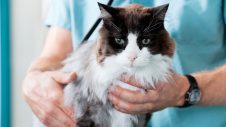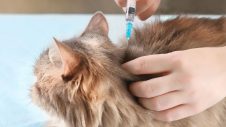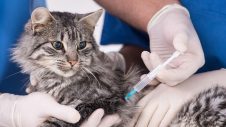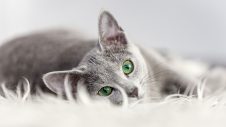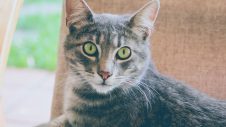Vaccinations and your feline friend

To safeguard your cat from fatal diseases, Greencross Vets urges routine vaccinations. A vaccination schedule is your pet’s best assurance against preventable disease.
Your Greencross Vet will tailor the best vaccination schedule for your pet. Below is a general guide to when your cat will require a vaccination.
Kittens – core vaccination schedule
- 6 to 8 weeks old – first vaccination.
- 10 to 12 weeks old – second vaccination.
- 14 to 16 weeks old – third vaccination.
Adult cats – booster vaccinations:
- Cats require booster vaccinations to ensure long-term immunity against contagious diseases like Feline Immunodeficiency Virus (FIV)
- If your cat is exposed to the outdoors, consider incorporating the FIV vaccine into your cat’s program (this can be given from 8 weeks of age).
Ongoing
Your Greencross Vet will tailor an ongoing vaccination program guided by your cat’s lifestyle and environment.
Unvaccinated pets are at risk of contracting serious diseases. Keep your sidekick safe and speak to your Greencross Vet today about the best possible vaccination program for their ongoing health.
How vaccines work
Vaccinations work by exposing a pet’s immune system to a small amount of the virus or bacteria through an injection.
This stimulates and encourages a pet’s immune system to produce antibodies that are effective against a virus or bacteria so it can eliminate the organism if an infection occurs. Following vaccination, the pet may be quieter than usual, and as with humans, a small number of pets may experience some tenderness around the injection site.
As with all vaccines, allergic reactions may occur, but they are rare.
Which diseases do vaccinations help protect my cat from?
The F3 vaccine provides protection against the following three viruses. This is referred to as a ‘core vaccine’ in Australia.
1. Feline Panleukopenia Virus
2. Feline Herpes Virus
3. Feline Calicivirus.
In addition to the above, for cats that are outdoors, unsupervised and could potentially interact/fight with other cats, it is worth discussing protecting your cat with the following non-core vaccinations.
1. Chlamydophila felis
2. Feline Leukemia Virus
3. Feline Immunodeficiency Virus (FIV).
More information about these diseases
Protected against by core vaccine
1. Feline Panleucopenia virus (also known as feline parvovirus or feline infectious enteritis) can cause severe haemorrhagic gastroenteritis. The virus is highly contagious amongst cats, and it can survive in the environment for long periods of time, making vaccination against it important.
2. Feline Herpes Virus causes upper respiratory symptoms in cats, such as sneezing, nasal discharge, conjunctivitis, ocular discharge, pharyngitis, inappetence, lethargy, and fever. It can also cause keratitis (inflammation +/- infection of the eye surface) with chronic infection. FHV is transmitted by direct contact (saliva, ocular and nasal discharge), inhalation of infected droplets in the air from sneezing, sharing food/water bowls and from the environment.
3. Feline Calicivirus causes upper respiratory symptoms in cats and can have very similar signs to Feline Herpes Virus (FHV). As well as respiratory symptoms, cats may also experience oral ulceration, excessive drooling, gingivitis, stomatitis and in very young kittens, pneumonia. FCV is transmitted by direct contact (saliva, ocular and nasal discharge), inhalation of infected droplets in the air from sneezing, sharing food/water bowls and from the environment.
Protected against by non-core vaccinations
1. Chlamydophila felis is a bacterium that can cause conjunctivitis, ocular infections, nasal discharge and sneezing. It is predominantly contracted via direct contact with other cats, as it does not survive well in the environment.
2. Feline Leukemia Virus causes immunosuppression in affected cats, making them significantly more likely to succumb to other diseases. Infected cats are at greater risk of developing anemia and cancers, such as lymphoma, leukemia and some other tumours. This virus is transmitted predominantly through saliva but can also be shed in urine, faeces, and milk.
FLV can be spread by social contact (e.g. mutual grooming, sharing food/water bowls and litter trays), has the potential to spread from bite wounds and is a very high risk for a mother cat to pass on to her kittens (if they survive till term at all, as many mother cats will lose the kittens before birth if they have this disease). It is estimated that about 1-2% of the cat population in Australia is infected with the virus.
3) Feline Immunodeficiency Virus (FIV) also causes significant immunosuppression. It is transmitted predominantly through bite wounds (saliva containing the virus, being directly injected into the bloodstream of a non-infected cat). It can also be transmitted from blood to blood, sexually transmitted, and there is a chance of it being passed from mother to kitten. FIV cannot survive long out of the body, so it is rare to contract it indirectly from the environment, shared food/water bowls, mutual grooming between cats, etc.
It is estimated that ~15% of cats across Australia are suspected to have this disease, but reports range from 7%-30% of the cat population, depending on the location and stray vs owned cats, around Australia.

 Greencross Vets
Greencross Vets 
